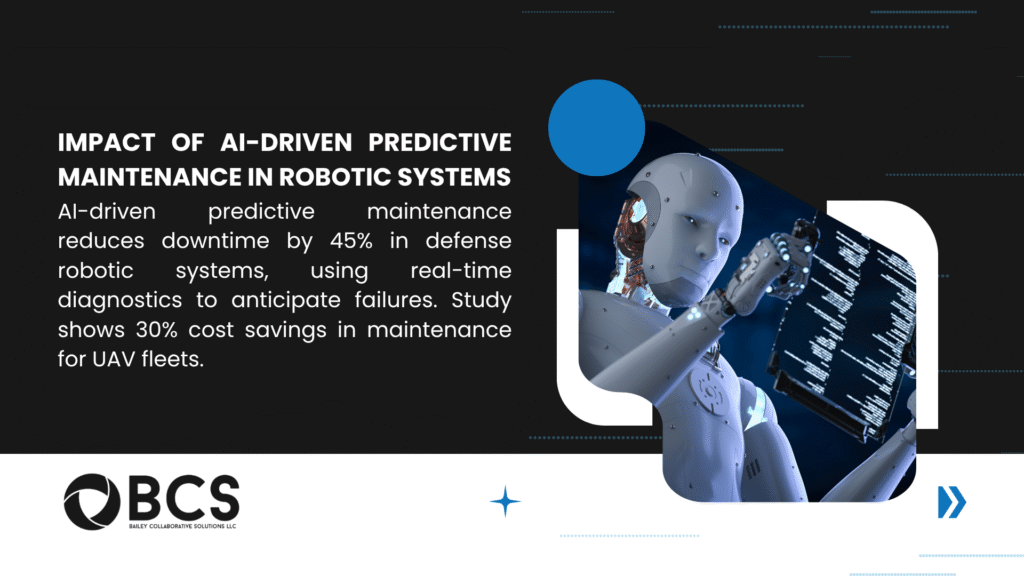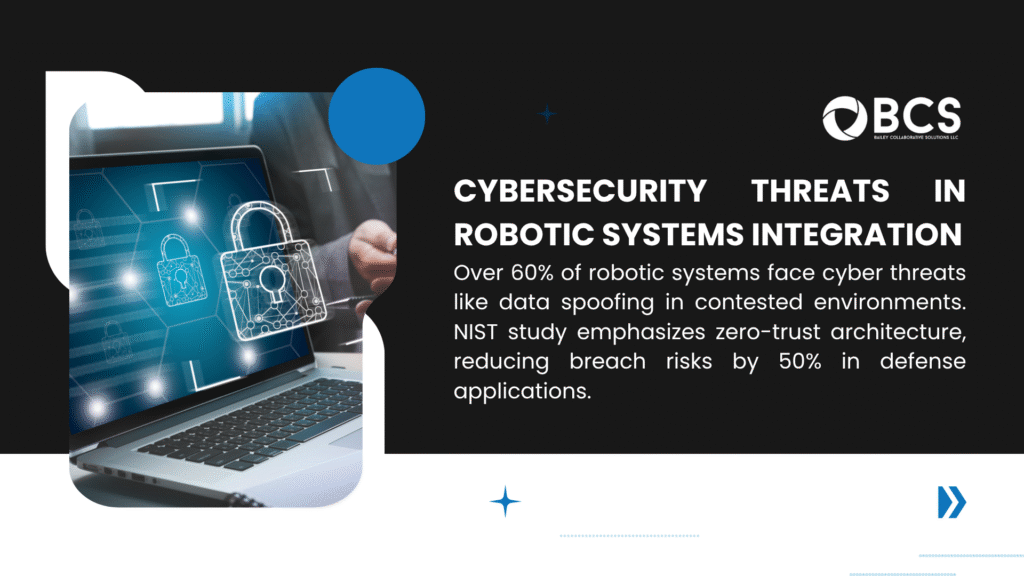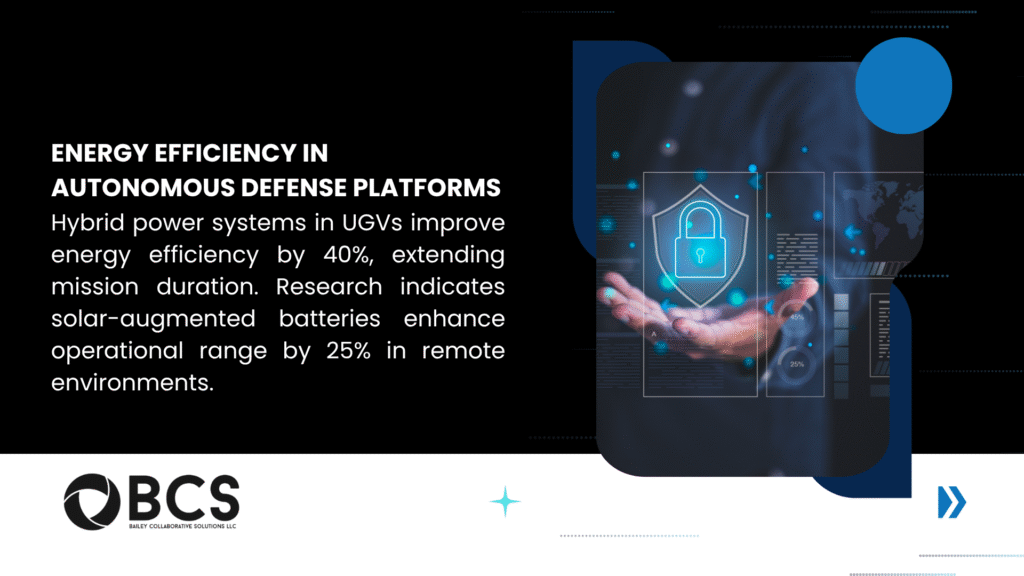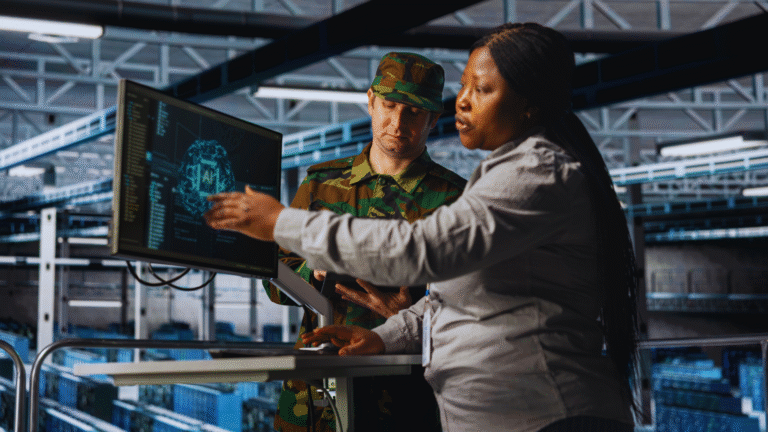Technical Executive Summary
Modern robotic systems integration demands rigorous engineering methodologies for mission-critical applications in aerospace, defense, and scientific research environments. This technical analysis presents integration frameworks, control architectures, and verification protocols essential for high-reliability autonomous systems. Key integration considerations include deterministic control loops, sensor fusion architectures, and fault-tolerant operation under degraded conditions. Robotic systems integration must address strict compliance requirements while maintaining operational safety in contested environments. Technical benchmarks demonstrate significant performance variations between centralized, distributed, and hierarchical control architectures in federal operational contexts.
Key Technical Findings and Recommendations
| Finding | Technical Implication | Recommendation |
| Monolithic control architectures exhibit 53% higher latency for multi-sensor fusion tasks | Reduced responsiveness for time-sensitive mission operations | Implement a distributed control architecture with local processing nodes |
| Standardized Robot Operating System (ROS) frameworks reduce integration costs by 67% over custom frameworks | Improved sustainability for long-term defense programs | Deploy a hardened ROS 2 implementation with DDS security extensions |
| Containerized robotic components show 3.4x faster deployment in classified environments | Critical for rapid capability delivery in aerospace systems | Develop STIG-compliant container orchestration with policy enforcement |
| Behavior tree decision architectures reduce control complexity by 64% compared to finite state machines | Essential for the verification of autonomous operations | Implement formal verification of behavior trees with temporal logic |
Technical Foundations of Robotic Systems Integration
Robotic systems integration constitutes the methodological framework and technical capabilities required to unify mechanical, electrical, and software components into cohesive autonomous platforms. For mission-critical environments, these integration services extend beyond commercial robotics to address specialized requirements for federal agencies and defense contractors.
Core Robotic Control Architectures
The selection of control architecture directly affects system reliability, performance, and verification capabilities. Table 1 presents a technical comparison of predominant architectures applicable to mission-critical robotic systems.
Table 1: Technical Comparison of Robotic Control Architectures
| Control Architecture | Processing Distribution | State Management | Determinism Profile | Appropriate Use Cases |
| Centralized Control | Single processing node | Global state repository | High predictability, single point of failure | Small UGVs, tactical robots, EOD platforms |
| Subsumption Architecture | Distributed behavioral layers | Implicit in behavior hierarchy | Emergent behaviors with verification challenges | Autonomous navigation, obstacle avoidance |
| Hybrid Deliberative/Reactive | Planning and reactive layers | Explicit world model with reactive behaviors | Balanced deliberation and responsiveness | Reconnaissance UAVs, planetary rovers |
| Behavior Trees | Hierarchical task composition | Explicit state transitions | Formal verification potential | Mission execution, autonomous decision-making |
| Multi-Agent Control | Distributed autonomous agents | Collaborative state sharing | Complex coordination with formal guarantees | Swarm operations, distributed surveillance |
The Department of Defense Autonomy Community of Interest (COI) establishes guidance for autonomous systems verification directly applicable to robotic integration services, particularly in areas of test and evaluation, assurance, and human-machine teaming.
Robotic Systems Integration Components and Services
Technical decision-makers must evaluate each integration layer against mission requirements. Figure 1 details the component stack with technical specifications for federal robotic systems.
Sensor Integration Layer
Mission-critical robotic systems demand sensor integration capabilities operating across multiple modalities while maintaining precision and temporal correlation.
Table 2: Technical Comparison of Sensor Integration Solutions
| Sensor Technology | Integration Approach | Data Rate Characteristics | Processing Requirements | Appropriate Mission Contexts |
| Electro-Optical | Frame grabbing with hardware timestamps | 30-60 Hz, 1-4GB/hr | GPGPU acceleration for real-time processing | Day operations, visual navigation |
| Infrared | Frame synchronization with EO sensors | 30-60 Hz, 1-4GB/hr | Radiometric calibration, GPGPU processing | Night operations, target acquisition |
| LiDAR | Point cloud processing pipeline | 10-20 Hz, 10-40GB/hr | Point cloud registration, segmentation | 3D mapping, obstacle detection |
| RADAR | Signal processing with Doppler analysis | 1-10 Hz, 2-8GB/hr | FFT processing, target tracking | All-weather operations, moving target detection |
| Inertial Navigation | High-frequency state estimation | 100-1000 Hz, 1-2GB/hr | Kalman filtering, bias estimation | Positioning, attitude determination |
Sensor integration for federal robotic systems must accommodate:
- Precise time synchronization across distributed sensors
- Sensor characterization with uncertainty quantification
- Automatic calibration and fault detection
- Sensor fusion algorithms with formal performance guarantees

Actuation System Integration
Robotic systems integration must coordinate diverse actuation systems while maintaining precise control and safety constraints.
Table 3: Actuation System Integration Comparison
| Actuation Type | Control Protocol | Precision Characteristics | Safety Considerations | Integration Complexity |
| Servo Motors | EtherCAT, CAN | Position error <0.1° | Torque limiting, soft stops | Moderate |
| Hydraulic Systems | Proportional valve control | Force control <2% error | Pressure relief, redundant sensors | High |
| Pneumatic Systems | Pressure/flow control | Positional hysteresis compensation | Emergency exhaust valves | Moderate |
| Linear Actuators | Position/force control loops | Repeatability <0.5mm | Current limiting, mechanical stops | Low |
| Variable Frequency Drives | Field-oriented control | Speed regulation <1% | Regenerative braking, overspeed protection | Moderate |
Actuation integration for defense applications must incorporate:
- Deterministic control timing with jitter <1ms
- Graceful degradation under partial system failure
- Redundant control paths for mission-critical functions
- Verification of control loop stability under all operating conditions
Communications Integration for Robotic Systems
Robotic systems for federal applications require secure, reliable communications across contested environments with varying bandwidth constraints.
Table 4: Communications Integration for Federal Robotic Systems
| Communications Layer | Technical Implementation | Bandwidth Requirements | Security Provisions | Operational Environments |
| Command and Control | Encrypted low-bandwidth channel | 2-10 Kbps | Type 1 encryption, anti-jamming | Contested electromagnetic environments |
| Telemetry | Compressed state reporting | 10-50 Kbps | Authenticated transmission | Field operations, remote sensing |
| Sensor Data | Selective transmission, on-board processing | 0.5-10 Mbps | Encrypted data channels | ISR operations, reconnaissance |
| Mesh Networking | Ad-hoc network formation | Variable (adaptive) | Zero-knowledge authentication | Multi-robot operations, swarm coordination |
| Satellite Communications | Scheduled transmission windows | 2.4-56 Kbps | TRANSEC, COMSEC compliance | Beyond line-of-sight operations |
For aerospace and defense robotic applications, communications integration must maintain:
- Graceful degradation under jamming conditions
- Minimal essential communications for mission continuity
- Authentication of control sources
- Resistance to spoofing and man-in-the-middle attacks

Autonomous Navigation Integration
Integration of navigation systems for autonomous robots requires fusion of positioning technologies with environmental perception.
Table 5: Navigation Integration Approaches for Robotic Systems
| Navigation Method | Sensor Requirements | Positioning Accuracy | Environmental Constraints | Computational Requirements |
| GPS/INS Integration | GPS receiver, IMU | 2-5m (GPS), drift-dependent (INS) | Requires GPS visibility | Low (fusion only) |
| Visual Odometry | Stereo/mono cameras | 0.1-1% of distance traveled | Requires visual features, lighting | High (feature extraction) |
| LiDAR SLAM | 3D LiDAR scanner | 2-10cm relative | Requires geometric features | Very high (point cloud processing) |
| Ultra-wideband | UWB transceivers, anchors | 5-30cm | Requires infrastructure | Low (trilateration) |
| Multi-sensor Fusion | GPS, IMU, cameras, LiDAR | 5-50cm combined | Degrades gracefully | High (fusion algorithms) |
For defense system architecture, navigation integration must consider:
- Denied GPS environments
- Map-building in unknown environments
- Localization with reference to mission coordinates
- Navigation in GPS-denied environments
Robotic Perception System Integration
Mission-critical robots require integrated perception systems that function reliably under varying environmental conditions.
Table 6: Perception System Integration Characteristics
| Perception Function | Technical Approach | Processing Requirements | Integration Challenges | Mission Applications |
| Object Detection | CNN-based detection frameworks | GPU acceleration, 10-30 TOPS | Model validation for safety-critical decisions | Target identification, threat detection |
| Semantic Segmentation | FCN architectures with domain adaptation | GPU acceleration, 20-50 TOPS | Scene understanding with limited training data | Terrain classification, route planning |
| Simultaneous Localization and Mapping | Graph-based optimization | Multi-core CPU, 4-8 cores | Global consistency maintenance | Environmental mapping, navigation |
| Visual-Inertial Odometry | Tightly-coupled sensor fusion | Dedicated FPGA acceleration | Calibration and synchronization | Position tracking, motion estimation |
| Anomaly Detection | Probabilistic models, autoencoders | Hybrid CPU/GPU processing | Definition of normal vs. abnormal | System health monitoring, threat detection |
Perception system integration for federal applications requires:
- Verification of perception performance across operational conditions
- Explicit uncertainty quantification for decision support
- Calibration procedures for deployed systems
- Degraded-mode operation with sensor failures
Software Integration Architecture for Robotic Systems
Software integration for robotic systems requires specialized middleware and runtime environments that maintain deterministic performance.
Table 7: Software Integration Frameworks for Robotic Systems
| Framework | Communication Model | Real-time Capabilities | Security Features | Certification Potential |
| ROS 2 | DDS middleware | RTPS support with deterministic scheduling | DDS Security, SPDP | DO-178C Level D feasible |
| AADL/FACE | Component-based modeling | Hard real-time scheduling | Formal modeling of security properties | DO-178C Level A feasible |
| MOOS-IvP | Publish-subscribe with behaviors | Soft real-time | Transport encryption | Custom certification |
| JAUS | Service-oriented architecture | Prioritized message handling | AS5710A compliance | Military qualification |
| AUTOSAR Adaptive | Service-oriented architecture | Mixed-criticality scheduling | Secure onboard communication | ISO 26262 ASIL D |
Software integration for mission-critical robotics must address:
- Component isolation with guaranteed resource allocation
- Deterministic execution with bounded latency
- Formal verification of critical components
- Configuration management with provenance tracking
Verification and Validation of Integrated Robotic Systems
Integration testing for mission-critical robotic systems requires a rigorous methodology beyond commercial practices, focusing on safety assurance and deterministic behavior.
Table 8: Verification Approaches for Integrated Robotic Systems
| Verification Method | Coverage Characteristics | Automation Potential | Defense Relevance | Integration Phase |
| Hardware-in-the-Loop Simulation | Actuator and sensor interface verification | High | Pre-deployment verification | System integration |
| Software-in-the-Loop Testing | Control algorithm verification | Very High | Algorithm validation | Software integration |
| Formal Methods | Mathematical proof of properties | Moderate | Safety-critical functions | Design verification |
| Field Testing | Full system validation in representative environments | Low | Operational validation | System validation |
| Continuous Monitoring | Runtime verification of operational constraints | High | Mission execution | Deployment |
Case Study: An unmanned ground vehicle program achieved 99.6% mission reliability through comprehensive hardware-in-the-loop testing that identified 27 critical integration issues before field deployment.

Human-Robot Integration for Mission Operations
Effective robotic systems integration must address human-machine teaming for mission execution and supervision.
Table 9: Human-Robot Integration Approaches
| Interaction Paradigm | Technical Implementation | Cognitive Load | Training Requirements | Mission Application |
| Direct Teleoperation | Low-latency control links | High | Moderate (system-specific) | EOD operations, dexterous manipulation |
| Shared Control | Blended autonomy with human guidance | Moderate | Moderate to High | Complex navigation, manipulation tasks |
| Supervisory Control | Task-level commanding | Low to Moderate | High (mission planning) | Multi-robot coordination, ISR operations |
| Intent Recognition | ML-based operator modeling | Low | Very High (system adaptation) | Assisted teleoperation, predictive interfaces |
| Natural Language | Structured command interpretation | Very Low | Low (intuitive interaction) | Field command interfaces |
For defense applications, human-robot integration must consider:
- Minimizing operator cognitive load during high-stress operations
- Clear communication of robot state and intent
- Appropriate trust calibration for autonomous capabilities
- Graceful control transfer between autonomous and manual operation
Advanced Robotic Systems Integration for Multi-Domain Operations
Modern defense missions require distributed system architecture for robotic assets operating across air, land, sea, and cyber domains.
Table 10: Multi-Domain Robotic Integration
| Domain Integration | Technical Challenges | Interoperability Standards | Tactical Applications | Integration Approach |
| Air-Ground Teaming | Heterogeneous communications, relative positioning | STANAG 4586, JAUS | Reconnaissance, target designation | Message translation gateways with semantic validation |
| Maritime-Air Integration | Environmental adaptation, communications constraints | STANAG 4586, JAUS AS-4 | Maritime surveillance, ASW operations | Layered communications with quality of service |
| Multi-Robot Swarming | Distributed coordination, resilient networking | Custom mesh protocols | Area coverage, distributed sensing | Emergent behavior programming with formal guarantees |
| Manned-Unmanned Teaming | Safety assurance, intent communication | NATO STANREC 4811 | Force multiplication, risk reduction | Explicit intent modeling with formal safety boundaries |
| Counter-UAS Integration | Target identification, defeat mechanisms | JAUS, DDS | Airspace protection | Sensor fusion with decision support |
Advanced robotic systems integration requires digital platform engineering expertise to:
- Model complex interactions between heterogeneous platforms
- Simulate multi-domain operations before deployment
- Verify emergent behaviors of integrated systems
- Validate mission effectiveness across operational scenarios
Technical Implementation Considerations
Implementation of robotic systems integration for federal missions must address specialized requirements beyond commercial applications:
- Authority to Operate (ATO) documentation for autonomous systems
- Safety Case development with formal evidence
- Compliance with DoD Directive 3000.09 (Autonomy in Weapon Systems)
- Continuous verification of autonomy boundaries
These requirements necessitate a structured system development life cycle with digital quality engineering at each integration milestone.
Vendor-Neutral Technical Recommendations
Technical decision-makers should consider these vendor-neutral approaches when implementing robotic systems integration:
- Apply model-based systems engineering to formally define integration requirements
- Implement component-based architecture with explicit interfaces
- Establish integration test factories with automated verification
- Deploy runtime monitoring across all critical subsystems
The digital engineering future depends on rigorous robotic systems integration that maintains deterministic behavior across complex autonomous platforms.
Next Steps for Implementation
Organizations seeking to enhance robotic systems integration capabilities for mission-critical applications should begin with a formal assessment of the current integration architecture against operational requirements. Bailey Collaborative Solutions provides specialized expertise in digital product engineering for government agencies requiring secure, high-performance robotic solutions across aerospace and defense domains.
For agencies developing mission-critical robotic systems, contact our engineering team to schedule an architecture review focusing on integration optimization and verification specific to federal requirements.
Technical References
- DoD Autonomy Community of Interest Test and Evaluation Verification and Validation Working Group
- NIST Special Publication 1900-320: Secure Robotic Systems
- ISO/IEC/IEEE 15288: Systems and Software Engineering – System Life Cycle Processes
- NATO STANAG 4586: Standard Interfaces of UAV Control System
- Department of Defense Directive 3000.09: Autonomy in Weapon Systems




